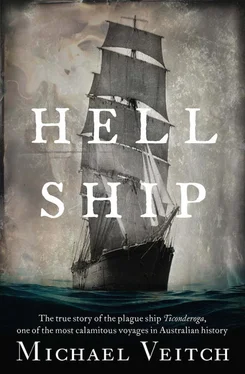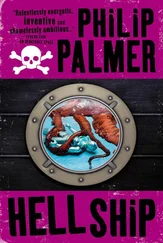For the Handos, like many other families, it would not be the last time they grieved.
As the Ticonderoga headed towards the equator, the weather and the ship began to heat up, which was another shock to those on board. Even the hottest day of the hottest British summer was nothing compared with this delirious, enervating onslaught that arrived with the dawn of each day, relieved only by the regular evening thunderstorm that caused the hatches to be battened down and water to once again leak profusely into the main and lower decks. The sea was at least mercifully calm, and as people gradually began to acclimatise to the motion, the incidence of seasickness dropped. But as the winds slackened around this part of the equator known to timeless seafarers as ‘the doldrums’, the ship’s progress slowed and the risk of being becalmed—sometimes for weeks—was real.
Captain Boyle seems to have avoided the worst of the doldrums, but nonetheless put up every possible piece of canvas he could manage to catch what breeze was offered. Poring over the charts, however, he began to have concerns about his ship’s progress. So far, there had been only a handful of deaths on board, and all the victims were young. In the Age of Sail, a fatality rate such as this was nothing out of the ordinary, and compared with some other voyages, it was even considered mild. Doctors Sanger and Veitch now began to elaborate somewhat on their earlier general diagnosis of ‘fever’ and reported that ‘scarlatina’—or scarlet fever, as it was later to be known—was presenting in some young patients. This was a bacterial infection particularly prevalent in children and infants, especially those of fair skin—which in the Scottish Highlands was virtually everyone.
Though it was not yet an epidemic, more cases of scarlatina began to take hold. Parents could only look on helplessly as their infected children were racked by the terrible symptoms: crushing headache, sore throat, vomiting. Then the spreading of the tell-tale bright pink rash, first on the tongue, then across their creamy white cheeks and finally covering their entire bodies as their temperature soared to over 100ºF. Associated infections of the middle ear and tonsils would break out, adding to the child’s terror and misery. The doctors did their best to cool the burning, and though some did survive the few days over which the disease ran its course, it was the soaring temperature that carried the children away in those days before antibiotics.
Boyle began to sense that his ship, carrying more people—many of them children—on a long voyage such as this, was in fact dangerously overcrowded. For this floating twin-deck experiment to arrive at its destination without disaster, a good deal of luck would be required.
On these hot nights, the regulations were sometimes relaxed and some passengers stayed up on the upper deck under the stars, relieved to be free of the stultifying chamber of the lower quarters. Sometimes the Highland country dancing of the girls would be allowed to relocate to the open deck, creating something of a carnival atmosphere. Paying passenger vessels were usually accompanied by small bands of musicians—hired German bands being particularly popular—but those in the Ticonderoga ’s single steerage class would have to make do with their own. There seem to have been a good number of fiddle and pipe players present to provide the tunes so beloved of the passengers from the towns, glens and villages. Above them, the canvas sails wafted—at times unconvincingly—watched always by the anxious eyes of the captain and crew, who willed the stronger breezes to come on. Boyle continually put up new combinations of sail, ordering this or the other rope to be pulled and that sheet furled or reefed, and the Ticonderoga , built to capture even the most insipid of winds, sailed on.
* * * *
Late on the morning of 4 September, after exactly a month at sea and as the ship’s bow cut her way south, a cry went up from one of the crew, ‘Sail!’ Nothing on a long ocean voyage created so much excitement as the sight of another ship on the high seas. Instantly the word went around like an electric charge. A stampede of feet rushed from everywhere to the bulwarks to catch a glimpse of this precious connection to the outside world. ‘There she is!’ pointed out someone as a small white cloud of full sail was spotted on the azure sea heading almost straight for them from the opposite direction off the port bow. ‘Raise the board!’ sounded a command, and two seamen held up a large sheet of blackened timber. On this, in chalk, had hastily been written, ‘ Ticonderoga —August 4—Liverpool’. The other vessel was a far smaller ship than the Ticonderoga , but the sight of her warmed the hearts of everyone on board. The closing speeds of the two ships amazed those who longingly watched her pass, agonisingly close, imploring the first mate and even the captain to stop and hail her, but Boyle, himself already alert and watching with his eye glued to his long glass telescope from his position up on the forecastle, politely pointed out that sadly this would not be possible. Sometimes, the passengers had heard, passing ships did hove-to and ‘speak’ in an exchange of news and even mail, but whatever hopes the Ticonderoga ’s passengers may have had for such an exchange were not to be realised this day somewhere way out in the middle of the Atlantic.
The Lima under Captain A. Yule was tracing the Ticonderoga ’s passage almost in exactly the other direction, [1] Kruithof, 2002, p. 50
travelling to England with a cargo of wool and a single solitary passenger after an extended delay in Port Melbourne. Having shipped a cargo of coal from Sydney, the Lima was forced to join the growing number of ships in Port Phillip Bay lying idle at anchor, abandoned by their crews who had absconded to the goldfields. She managed to set sail in late April, but the reason for her taking four months or so to reach the Ticonderoga ’s position is unclear. Still, peering intently through his glass, Boyle tried his best to steady himself on the binnacle and focus, cursing under his breath at the rocking of the ship. ‘Mark her as…,’ he called at last to his Mate, ‘ Lima … 130 days out’. Across the narrow stretch of water, the crew of the Lima had likewise raised their board, but heading north, were able to impart to the Ticonderoga one vital piece of information Boyle did not want to miss.
‘Four days up from the Line,’ he read. ‘That puts us… where, First Mate?’
‘I’d say about eight points north, Captain.’
‘I concur,’ said Boyle.
‘She is doing well, Captain,’ said the Mate.
‘She is doing very well, first mate. Very well indeed!’
In a time-honoured tradition, the two ships had exchanged their names and estimated positions, still in this age determined by nothing but a doubtful ship’s clock, the position of the sun and mental arithmetic. The Lima , having gradually watched the sun’s zenith rise and fall, could report that it had crossed the important ‘line’ of the equator just a few days earlier. The news pleased Captain Boyle immensely. The Ticonderoga was racing down the world, making excellent time.
The passengers listened to the exchange as the Lima passed by then quickly vanished from view, swallowed up in the endless blue seascape. That same day, another child, four-year-old Robert Moorhead, travelling with his family of nine, died—again of scarlatina. His mother, Eliza, was beside herself at the death of her youngest, but her grief would be short-lived. Soon, she too would be joining him.
Читать дальше












